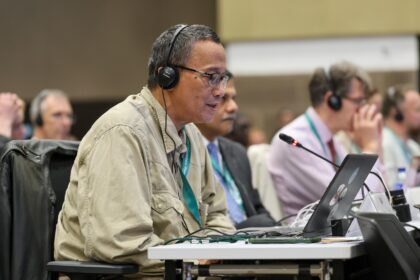[ad_1]
SEOUL – Despite a late start, ongoing supply issues and a heavy reliance on the controversial AstraZeneca shot, South Korea’s goal of herd immunity by November is still within reach, an official told foreign journalists in Seoul on Wednesday.Â
“Our goal is to provide vaccinations for everyone in the country and achieve herd immunity by November,†Bae Kyung-taek, the director-general of the Covid-19 Vaccination Task Force of the Korea Disease Control and Prevention Agency, or KDCA, said. “We have experienced some problems along the way, but we still see this as achievable.â€
Bae said he expects current global vaccine bottlenecks to be resolved by the autumn.
Last year, South Korea pioneered a winning Covid-19 containment strategy that combined mass testing with high-tech contact tracing, enabling early detection and fast treatment.
That strategy – well communicated by daily government briefings and deployed among a population with high levels of personal hygiene, a habit of mask-wearing and a broad propensity to follow government rules – allowed the country to contain the pandemic without economically debilitating lockdowns.
As a result, South Korea had some of the lowest death rates in the developed world and also achieved the best overall economic growth in the OECD in 2020. The approach was widely praised overseas and catapulted South Korea into the ranks of the top 10 countries worldwide in Bloomberg’s Covid Resilience Ranking.
According to Bloomberg, “snuffing out or containing Covid early continues to pay off in quality of life†for countries at the top of the list. South Korea is currently in sixth place.
However, the ranking warned “these places are lagging on vaccinations as low caseloads have made the virus a distant threat,†meaning that “going forward, that could put them at a disadvantage.â€
That logic certainly seems to apply to South Korea, which according to the FT’s Global Vaccine Tracker is in 74th place globally in terms of vaccinations per 100 people – behind Ecuador, Oman, Equatorial Guinea and the Palestinian Territories.
The country has vaccinated just 2.3% of its population with at least one shot to date, but according to the FT Tracker, has managed to fully vaccinate only 0.1% of its 52 million people.
The country started inoculations on February 26 with the elderly in care facilities and has since expanded target populations to include medical workers treating Covid patients, those over 75 living at home and those set to travel outside the country on essential trips.
Only in May will those with chronic illnesses, teachers of the disabled and secondary medical workers such as pharmacists be inoculated.
“Our government is making all-out efforts with inter-ministerial capacities,†Bae said, adding: “We are using public and private medical facilities.â€
Still, he admitted that there were issues. South Korea was late to order from global vaccine companies, putting it at the back of supply queues, and also relied heavily on the global Covax project.
A further issue concerned previous hopes for the early development of a local vaccine in a country where the pharmaceutical industry receives considerable government backing.
“The Korean government employed a strategy of both importing foreign vaccines and domestic R&D,†Bae said. “That was great for the researchers, but because of that, I guess we were slower to start the process.â€
Bae anticipates South Korea’s domestically designed vaccines coming online early next year.
Like other countries, South Korea is currently suffering a shortfall in vaccine delivery due to bottlenecks in the international supply chain and due to multiple countries’ decisions to halt the use of certain vaccines, notably AstraZeneca’s, over the risks of side effects.
Still, there are grounds for optimism.
In addition to the ongoing upgrade in global capacities, Bae noted that there was a wide range of additional vaccines now undergoing trials or in the approval stage. Given this, he predicted that supply bottlenecks would evaporate by the autumn.
The country has so far relied heavily on the AstraZeneca vaccine, the first inoculation approved for use and supplied to the country in February. Despite widespread concerns about blood clotting risks, particularly in the EU, the KDCA continues to allow its use for all but those under 30 years of age.
“We reached the conclusion that for people above 30, the benefits of vaccinations outweigh the risks, but for people under 30, it will be better for them to receive a vaccination at a later time,†Bae said.
Moreover, Bae said that South Korea would continue to administer the AstraZeneca shot in second doses to those who showed no adverse effects from the first inoculation. There are no plans in place at present to undertake “cross vaccination†– that is, using different vaccines for a patient’s first and second shots.
In March, the Pfizer-BioNTech vaccine was approved for use in South Korea. Beyond the Pfizer and AstraZeneca shots, no other vaccine is now being distributed.
Looking ahead, some 20 million Novavax vaccines are expected to come into use in June. Discussions are also underway with Johnson & Johnson, whose vaccine is now suspended in the US over blood clotting concerns.
The AstraZeneca vaccine is now being manufactured in South Korea by SK Bioscience, and distributed both locally and internationally via Covax, Bae said. South Korean firms are expected to begin production of Russia’s Sputnik V and the Novavax vaccine in the near future.
Could South Korea – as a manufacturer of vaccines – halt exports to prioritize its own populace, as has been rumored?
“Our government does not have plans to restrict exports of Covid-19 vaccines,†Bae said. “There have not been specific discussions or policies regarding export bans.â€
However, that does not mean the possibility is off the table. “If the domestic Covid-19 situation becomes much more serious, that could be a discussion that might happen,†he said.
At present, the country’s daily number of new Covid-19 infections is fluctuating between the mid-600s and the low-700s, leading authorities to mull additional social distancing measures. The highest daily caseload so far this year was 869, recorded on January 7.
[ad_2]
Source link













